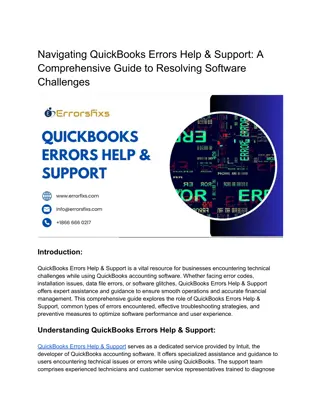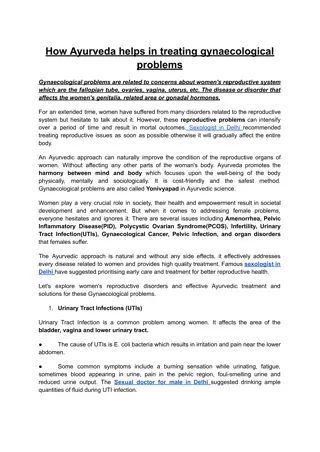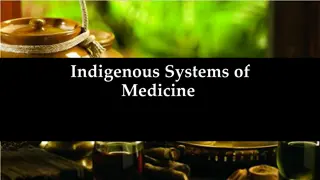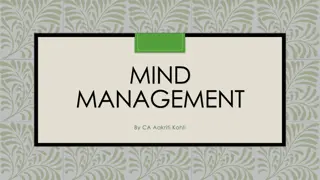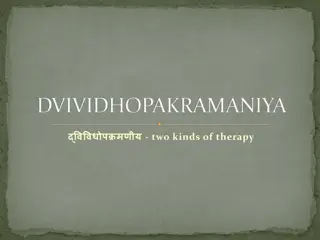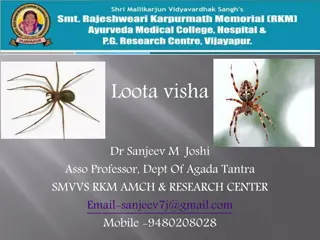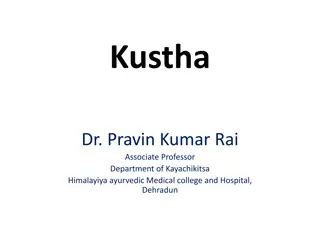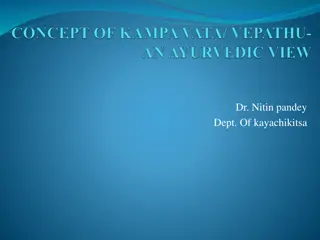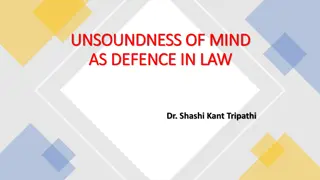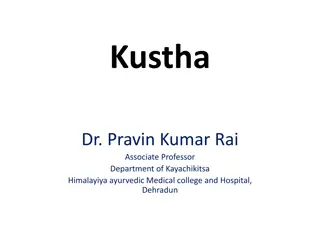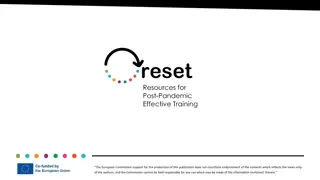Understanding the Concept of Mana/Mind in Ayurveda
The concept of Mana or Mind in Ayurveda is explored, discussing its etymology, definition, and functions. Mana serves as the mediator for understanding, perception, and cognition, influencing actions and decisions based on its objects, such as Chintya and Vicharya. It plays a crucial role in controlling sense organs, self-restraint, hypothesis, and consideration according to Ayurvedic principles.
Download Presentation

Please find below an Image/Link to download the presentation.
The content on the website is provided AS IS for your information and personal use only. It may not be sold, licensed, or shared on other websites without obtaining consent from the author. Download presentation by click this link. If you encounter any issues during the download, it is possible that the publisher has removed the file from their server.
E N D
Presentation Transcript
Concept of Mana/Mind in Ayurveda Presented by: Saurabh Yadav Department of Kriya Sharir Assistant professor HAMC&H Date-09/05/2020
Etymology and Derivation: Manah The word Mana is derived from root word Mana on adding the suffix Asuna , with the following meanings. Which perceives Which leads to knowledge Which analyses by special knowledge Mind or psyche
Chitta The word Chitta is synonymous with Mana and denotes - Mind - Mediator for understanding - Mediates perception - Awakes, provides sense - Examining and evaluating instrument Thought process (thinking), imagining, thought, intention, aim, wish, intelligence, reflecting, memory, reason, heart, mind, soul, spirit.
Definition of Manasa One which establishes the contact between the soul and body and which regulates the functions of the Indriyas is defined as a Mana. One which is responsible for the perception or non perception of knowledge is called Manasa.
Vishaya (Objects) of Mana | ||(Ch.Su 8/21) The objects of Mana are : Chintya (things requiring thought) Vicharya (consideration) Uhya (hypothesis) Dhyeya (emotional thinking), Sankalpya (determination) or whatever can be known by mind, are regarded as its subjects.
Chintya: Which is required to think about to do or not to do, and with or without purpose. Vicharya: It is a distinct analysis, which directs the mind to accept or reject a thing. Uhya: It is a speculation, hypothetical self-discussions and logical thinking about a condition. Dhyeya: concentration on specific object. Sankalpa: determination of mind about a thing. Other objects: Any other knowledgeable entity.
Functions of Manasa: | , ||(Ch. Su 8/21) The functions of Mana are Indriabhigraha (control of sense organs), Svasyanigraha (self restraint), Uhya (hypothesis) and Vichara (consideration). Indriabhigraha Mana is called as the controller of senses because it indicates to receive and send the impulse and impels the cognitive senses for perception of objects.
Svasyanigraha Controlling of own function or self control is another function of Mana. It is called Chanchala, so it is necessary to have Svasyanigraha to have right orientation towards desired objects and retraction from those after the purpose is fulfilled. Uhya Chakrapani explained in favor of Uhya that knowledge of imaginary objects, which produced by complete examination by mind is Uhya. It can be labeled as Alochana Gyana and it is in the form of Nirvikalpa Gyana
4. Vichara Chakrapani stated that thinking upon perceived object for its reception (Upadeya) or rejection (Heya) is Vichara.
| , || ||(ch.su.1/48) Panchmahabhuta, soul, mind, time and space constitute the matter. In this verse without the mind body and soul can not manifest the sentient itself. So the soul in combination with mind and body is sentient.
Qualities of mind: , , || (ch.su 8/4) Mind on the other hand, transcends all sense perception. It is known as sattva; some call it cetas. Its action is determined by its contact with the objects(like happiness, misery etc;)and the soul; this act as a driving force for all the sense faculties.
The role of mind in perception: || (Ch.Su 8/4) The sense faculties (like Chakshu, Shrotram, Ghranam, Rasanam, Sparshanam) are capable of perceiving their respective objects only when they are motivated by mind.
Process of perception of knowledge | ( Ch.Sha.1/122) Objects are perceived with help of sense organs together with the mind. This perception is purely mental bin for initiation, the practical advantages or disadvantages are ascertained thereafter.
Factors determining the quality of mind ( Ch.Su. 8/6) The mind of a person is qualified on the basis of the type of his repeated action. It is so because that quality must be predominating. In spite the ever-changing state of mind, there is one and only one quality which predominates an individual. This predominance is judged by the frequency of a given quality in an individual.
Guna of Manasa Anutvam (atomic dimension) Ekatavam (oneness or singleness) are considered to be the two characteristic of the Mana. There are very basic characters of the mind. If it were not so, all kind of perceptions would have occurred at a time.
, ; , ; |ch.su.8/5 In the same individual, the mind appears to be in multiple characters due to variations relating to the experience of its objects, perceptions of the objects of the sense faculties, its disposition and also its contact with Rajas, Tamas and Sattva qualities
But actually speaking, there is no multiplicity of mind. It is one and only one. so it does not motivate more than one sense faculty at a time ; and that is why all the sense organ not active simultaneously.
| || || 8 Thinking constitute the object of the mind. So the proper utilisation or excessive utilisation, non utilisation and wrong utilisation of mind or memory faculty is responsible for normal and abnormal mental conditions.
Seats of Mana Hridaya Charaka and Sushruta have mentioned that only Hridaya is the seat of Chetana in the body. Vagbhatt has also considered the Hridaya is the actual seat of Mana. Hridaya is considered to be the seat of Trigunas that are Normal characteristic of Mana.
Shira It has been explained that Prana and Indriyas are situated in Uttamanga i.e. Sira. Among the whole Indriyas, Manasa is the supreme because it is the controller of them. Sarva Sharira The whole of the body is the seat of mind. Mind is continuously active, so it cannot stay at one particular place
| | - , , ; | ( Ch.Vi.8/119) Sattva is mind and it regulates the body because of its association with the soul. Depending upon its strength it is of three types- Pravar(superior)-pravar sattva people are those having characteristics like sattva sara. Pravar sattva people tolerate serious exogenous and endogenous diseases without much difficulty.
Madhyam (mediocre)- individuals having mediocrity of mental faculties tolerate the pain themselves when they realise that other can also tolerate it, then they at times gain strength from others. Avar (inferior)- people with inferior mental faculties unable to sustain their mental strength even though they are motivated by others. They are susceptible to fear, grief, greed, delusion, ego and mild pain.
Characteristics of Good status of Sattva ( Examination of Sattva Sara): | (Ch. Vi. 8/110) Individual having the excellence of mental faculties are characterised by good memory, devotion, gratefulness, wisdom, purity, excessive enthusiasm, skill, courage, valour of fighting, absence of sorrow, proper gait, depth of wisdom and sincerity in actions and virtuous acts.
Manasika Bhava/Vikara: Anything that affects the physiology of Mana can lead to its psychopathology i.e. abnormal state of mind. These pathological conditions of Mana are considered as Manasika vikaras or Psychological disorders. Manasika Bhavas are defined as physiological states of Mana like Kama, Krodha, Lobha, Moha, Harsha. When these Bhavas are within physiological limits then they are considered as normal and constitute a healthy state of Mana and Sharira..
When the physiology of these Mana Bhavas,are disturbed then they are considered as abnormal and constitute a pathological state of Mana leading to Manasika Vikaras. Even the mental constitution called as the manasa Prakriti like the Shareera prakriti remains unchanged throughout the life. Rajas and Tamas, being two psycho-pathological factors, affect the mind and produce certain pure and primary mental disorders known as Manas Vikaras. Simply these can be defined as Abnormal State of Mind . The character of Abnormal State of Mind (ASM) is
Impairment of Mana Karma (General Mental Functions) viz. Indriyabhigraha (Perception and Motor Control in the absence of organic problems), Manonigraha (Mind control), Uhya (Hypothetical self discussion), Vichara (Critical analysis based on observations) and different aspects of Manasa viz. Buddhi (Decision), Smriti (Memory), Sangya-gyana (Orientation and responsiveness), Bhakti (Desire of faithfulness), Sheel (Conduct), Chesta (Psychomotor activity), Achara (Psychosomatic activities) severally or in combination.
Practices preventing psychosomatic disturbances For preventing psychosomatic disturbances and for the maintenance of the positive health and control of sense faculties one should always follow the code and conduct like: Respects to the gods, teachers, brahmins, preceptors, elederly people etc offer oblation to the herbs, wear good herbs Have a haircut, shave and nailcut-thrice in every 15 days, clean excretory passage and feet frequently Wear good apparel, apply scent, always apply oil to the head, ears, nostrils and feet,comb hair, be happy
Speak timely beneficial, measured sweet words, be self controlled and virtuous, envy in action but not in the results Be careful ,fearless, clever and devoted to teachers who have attained spiritual perfection and are advanced in modesy, intellect, learning. Be friendly to all creatures, reconcile the angry, console the frighttened, be merciful to the poor Be predominantly of compromising nature and tolerant towords unpalatable words uttered by others, be controllers of intolerance, be of peaceful disposition and conquor the very roots of attachment and hatered. (ch. Su 8/18)
Principles of preventing psychic disturbances Normally, mind, including sense faculty remains undisturbed. In order that they are not disturbed in any way, one should make all the efforts to maintain their normal condition. this can be achieved by The performance of duties after duly considering their pros and cons with the help of the intellect together with the sense faculties applied to their respective wholesome objects By acting in contradistinction with the qualities of place, season and one s own constitution including teperament. So one, who is desirous of his own well being should always perform noble acts with proper care. (ch.su.8/17)
Proof of existence of mind and its attributes- | || || | (ch.sha 1/19) sometimes one understands a thing and sometimes one does not. This proves the existence of the mind as a separate sense organ. When there is no contact of mind with sense organs and their objects, no understanding of things can occur. It is only when the required mental contact is there. Atomicity and oneness are considered to be the two characteristics features of the mind.
Applied aspect of Mana On the basis of mind-body interaction various Manasika Bhavas or Manasika Bhava Vikaras can be classified as follows. 1. Manodhisthita Manasa Vikara Here only Manasa Vikaras included. They are. Kama (Desire) Krodha (Anger) Lobha (Greed Chittodvega (Anxiety) Chinta (Worry) Bhaya (Fear)
2. Nanatmaja Manasa Vikara Here Sharirika Doshas vitiate Mana and manifestation of Manasa Roga will occur. They are: Ashabda Shravana (Auditory Hallucination) Tama (Withdrawal) Bhrama (Confusion) Vishada (Malaise) Atipralapa (Prating) Asvapna (Insomnia) Anavasthitachittatva (Fickleness or anxiety) Nidradhikya (Hypersomnia) Tandra (Stupor)
Sharira Manodhisthita Manasa Roga Here both Sharirika Doshas and Manasa Doshas Vitiate equally. Unmada (Psychosis) Apasmara (Epilepsy) Atatvabhinivesha (Anxiety) disorder Apatantraka Aptaanaka (Hysteria)
Mada (Intoxication) Murchha (Fainting) Sanyasa (Coma) Madatyaya (Alcoholism) Vishajaunmada (Toxic psychosis) Jalasantrasa (Hydrophobia)
4. Manoshariradhisthana Manasa Vikara Shokaja Jwara (Fever due to Grief) Kamaja Jwara (Fever due to Passion) Krodhaja Jwara (Fever due to Anger)
5. Manasa Vikaras Causing other Rogas - Here mental abnormalities or Manasa Vikaras aggravate Sharirika Vyadhi. Here Sharirika Vyadhis potentiated by Manasa Vikaras. The somatic diseases wherein psychological factors involved are as follows.
Etiology of the disease - Psychosomatic Approach In Vimana Sthana, Acharya Charaka has described the etiopathogenesis of all the somatic diseases on the basis of Manasika Bhavas. He concluded that all the somatic diseases are originated from the psychological factors like Lobha, Kama, Krodha, Moha etc. Acharya Charaka has emphasized there that root cause of derrangement of four factors (i.e. Vayu, Jala, Desha, Kaal) responsible for epidemics is unrighteousness i.e. Adharma.
Acharya Charaka has very nicely explained about the origin of Manasika Bhava from this Adharma (unrighteousness). He explained that at declining of Kritayuga i.e. golden age, those persons who were better circumstance, due to overindulgence, heaviness of the body (Sharira Gaurava) occurred. Heaviness gave rise to fatigue, lassitude, hoarding and greed. In this way this 1st Manasika factor i.e. Lobha came in to existence at the end of golden age (Sata Yuga).
Presence of Alpasatva (weak psyche or psychic energy) in the genesis of illness. The involvement of both Sharirika and Manasika Doshas combined or only Manasika Doshas. The involvement of both the Adhisthana (organ of genesis viz. Sharira and Manasa or Mana alone). The classical identification of illness either as Manasa Vikara or Ubhayatmaka Vikaras. Vitiation of Manovaha Srotasa and Manodhisthana i.e. Hridaya.
Characteristics of a mentally healthy person A mentally healthy person is free from internal conflicts. He is well adjust i.e. he is able to get along well with others. He has strong sense of self-esteem He knows himself, his needs, problems and goals He faces problems and tries to solve them i.e. coping with stress and anxiety.
Mental health in ayurveda: (Su.Su.15/41) - includes physical health - includes sensorial, mental and spiritual health.
Mental status examination general appearance and behaviour speech mood and affect thought perception cognition insight judgement
Promotion of mental health Practice of swasthavritta and sadvritta Practice of yoga, spirituality and positive thought Achara, Ajasrika and Medhya Rasayana Sattvika Ahar-Vihar
Specific techniques for sattvavajaya || || (Ch. Su 1/58) || || (Ah.Su 1/26) || (Ch. Su. 11/46) | || (Ch. Su. 11/47)
Scope of Sattvavajaya therapy Ayurveda considers three important factors in the causation of the diseases-both physical and mental Pragyaparadha (Intellectual Blasphemy) Asatmyendriyartha Samyoga (Incompatible contact of sense organs with objects) Parinama (Time factor including chronobiolgical errors) | || (Ch.Su.1/87)
Cont.. Caraka, while describing the causative factors for miseries, gives a fair amount of importance to Pragyapradha (intellectual blasphemy). He says a person whose intellect, patience and memory are impaired subjects himself to intellectual blasphemy, by virtue of his evil actions. Intellectual pseudo conception and improper conduct represent intellectual blasphemy. All this comes under the preview of the mind as the intellect is the direct product of mind and the conduct originates from the former.
Intellectual blasphemy aggravates all the Dosas. Caraka enumerates various ailments which manifests as a direct consequence of impairment of intellect, patience, and memory (i.e intellectual blasphemy). Besides this, other two major causative factors namely Astmyendriyartha Samyoga and Parinama, may also come under the preview of Pragyaparadha because it is ultimately the Pragyaparadha that leads to these two causative factors. Thus intellectual blasphemy is the main causative factor of all the mental and most of the physical derangements.
Applied aspects of Sattvavajaya 1. Assurance 2. Replacement of emotions 3. Regulation of thought process 4. Re-framing of Ideas 5. Channeling of Presumptions 6. Correction of objectives and ideals. 7. Proper guidance and advice for taking right decisions 8. Proper control of patience.
THANK YOU for any query please contact on my whats app no. 9451970433
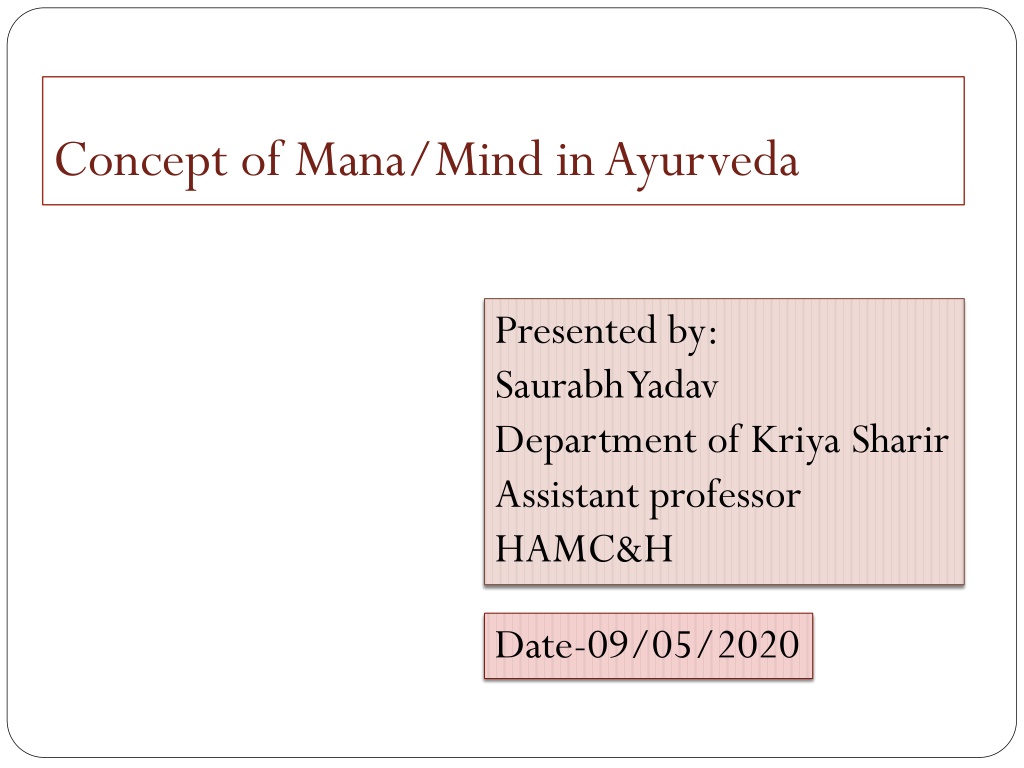

![[PDF⚡READ❤ONLINE] Zen Mind, Beginner's Mind: 50th Anniversary Edition](/thumb/20459/pdf-read-online-zen-mind-beginner-s-mind-50th-anniversary-edition.jpg)

